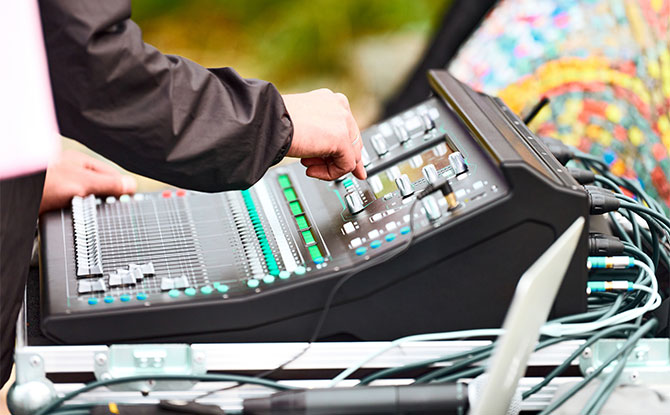Audio engineers work with sound systems. But what exactly are sound systems? Is the sound system the same as the arrays of buttons and knobs found on in front of the audio engineer at a mixing desk? Or is it the speakers?
The Purpose of a Sound System
Let’s start at the beginning.
The purpose of a sound system is to reproduce a sound source.
In a live performance setting, sounds originate from a sound source. This is normally acoustic in nature.
Examples of sound sources include the human voice, a guitar string being plucked or a drum being struck. These sound sources produce sound waves that travel through the air to reach the listeners ears.
This is all well and good when you just have a few listeners who can hear the waves directly from the source. However, what happens when there are many people and they are all clamouring to hear the sound source?
One option would be for the sound source to increase its amplitude. This could mean that a person talking needs to raise his or her voice. Or the guitarist needs to strum even harder to get the strings to vibrate at a larger amplitude.
However, even then, this eventually reaches a limit.
That’s where a sound system comes in.
The purpose of a sound system, in a live sound context, is to reproduce and amplify the sound source or sources.
It takes acoustic sound waves, converts it into electrical signals that can then be amplified, before converting them back into acoustic sound waves to reach the ears of listeners.
Parts of a Sound System
Any sound system, no matter how simple or complex, can be broken up into three sections.
Input Section
The input section is where the acoustic sound get captured and gets converted into electrical signals. This is most commonly done with a microphone.
A microphone picks up the incoming sound waves and converts them into an electrical signal. This electrical signal gets sent to the next section of the sound system.
Mixing Section

The mixing section of a sound system is where the incoming electrical signals can be adjusted, processed and combined.
If the incoming electrical sound signal is too weak, it can be adjusted by raising up its level.
The signal can also be processed. For example, using an equalizer, you can boost or cut certain frequencies that are present in the signal.
Lastly, the mixing section is where you can combine different incoming signals and send them to different outputs where they are required.
Output Section
The output section is where electrical signals get converted back into acoustic sound waves.
But before it can do so, the electrical signals need to be amplified. This basically entails stepping up the power voltage of the signal so that it is more powerful than before. This is done using a power amplifier, a piece of equipment that steps up the voltage of the signal.
Once the signal has been amplified, it is then sent to the loudspeakers, where it is converted from electrical signals back into acoustic sound waves.
Signal Flow Through the Sound System
This is how sound journeys through a sound system. It first gets captured at the input section, then it is sent to the mixing section before finally being converted back to sound waves.
This is the signal flow through a sound system.
Sound System Model
A simple sound system may just have one piece of equipment at the input section and then it could pass on to the mixer, through an amplifier and out from one loudspeaker.

In larger, more complex sound systems, there could be tens of microphones on a stage. All the inputs from these microphones could then be sent to a mixing desk some where in the middle of a hall where all the inputs are mixed together and processed. Then the mixed signal could then be sent out to a rack of power amplifiers and to a stack of loudspeakers hanging from the ceiling at the side of the stage.
Nonetheless, whether it is a simple one-microphone system or a complex concert setup, both of these sound systems can be broken up and understood using the same input, mixing and output model.

